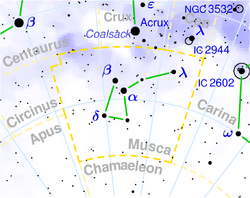Astronomy:Lambda Muscae
| Observation data Equinox J2000.0]] (ICRS) | |
|---|---|
| Constellation | Musca |
| Right ascension | 11h 45m 36.41916s[1] |
| Declination | −66° 43′ 43.5440″[1] |
| Apparent magnitude (V) | +3.63[2] |
| Characteristics | |
| Spectral type | A7 V[3] |
| U−B color index | +0.14[2] |
| B−V color index | +0.16[2] |
| R−I color index | 0.08 |
| Astrometry | |
| Radial velocity (Rv) | +15.0±0.3[4] km/s |
| Proper motion (μ) | RA: −100.35[1] mas/yr Dec.: +33.49[1] mas/yr |
| Parallax (π) | 25.65 ± 0.34[1] mas |
| Distance | 127 ± 2 ly (39.0 ± 0.5 pc) |
| Absolute magnitude (MV) | +1.07[5] |
| Details | |
| Mass | 1.88[6] M☉ |
| Luminosity | 40[7] L☉ |
| Surface gravity (log g) | 3.87[6] cgs |
| Temperature | 8,164±278[6] K |
| Rotational velocity (v sin i) | 57.7±1.7[5] km/s |
| Age | 740[6] Myr |
| Other designations | |
| Database references | |
| SIMBAD | data |
Lambda Muscae, Latinized from λ Muscae, and often catalogued HD 102249 or HIP 57363, is the fourth-brightest star in the Southern Hemisphere constellation of Musca (the Fly). Lambda Muscae visibly makes up the far end of the tail of the visual Musca constellation. It is a star in a dual system according to studies, and one of the stars catalogued in astronomer Johann Bayer's 1603 publications Uranometria. Lambda Muscae more recently has been recorded as having a stellar classification of A7III. Thus, Lambda Muscae has a white tint and burns significantly hotter than the Sun.
Distance and visibility
Based on research done by the European Space Agency for the Hipparcos Star Catalogue, Lambda Muscae exhibits a parallax of 25.42 milliarcseconds.[8] With this data it can be calculated that Lambda Muscae is situated at a distance of 39.3 parsecs, or 128.0 light years, away from the sun.
Lambda Muscae is a star of the third magnitude (or 3.68(v) to be exact) when viewed from the Earth, and is visible to the naked eye in regions that lack dense light pollution.
Lambda Muscae is the farthest right star in the visual constellation of Musca and is thus the tail of the fly.
Stellar characteristics
Lambda Muscae has a listed spectral type of A7V.[9] The A7 portion of this designation that Lambda Muscae is a class A7 star, meaning the light it emits is bluish-white in color and burns at a temperature significantly hotter than the sun, which is a G2 star. A7 stars are on the larger end of the Harvard spectral classification list, being only smaller and dimmer than Class-O and Class-B stars.
References
- ↑ Jump up to: 1.0 1.1 1.2 1.3 1.4 van Leeuwen, F. (2007), "Validation of the new Hipparcos reduction", Astronomy and Astrophysics 474 (2): 653–664, doi:10.1051/0004-6361:20078357, Bibcode: 2007A&A...474..653V.
- ↑ Jump up to: 2.0 2.1 2.2 Mermilliod, J.-C. (1986), "Compilation of Eggen's UBV data, transformed to UBV (unpublished)", Catalogue of Eggen's UBV Data (SIMBAD), Bibcode: 1986EgUBV........0M.
- ↑ Gray, R. O. et al. (2006), "Contributions to the Nearby Stars (NStars) Project: spectroscopy of stars earlier than M0 within 40 pc-The Southern Sample", The Astronomical Journal 132 (1): 161–70, doi:10.1086/504637, Bibcode: 2006AJ....132..161G.
- ↑ de Bruijne, J. H. J.; Eilers, A.-C. (October 2012), "Radial velocities for the HIPPARCOS-Gaia Hundred-Thousand-Proper-Motion project", Astronomy & Astrophysics 546: 14, doi:10.1051/0004-6361/201219219, A61, Bibcode: 2012A&A...546A..61D.
- ↑ Jump up to: 5.0 5.1 Ammler-von Eiff, Matthias; Reiners, Ansgar (June 2012), "New measurements of rotation and differential rotation in A-F stars: are there two populations of differentially rotating stars?", Astronomy & Astrophysics 542: A116, doi:10.1051/0004-6361/201118724, Bibcode: 2012A&A...542A.116A.
- ↑ Jump up to: 6.0 6.1 6.2 6.3 David, Trevor J.; Hillenbrand, Lynne A. (2015), "The Ages of Early-Type Stars: Strömgren Photometric Methods Calibrated, Validated, Tested, and Applied to Hosts and Prospective Hosts of Directly Imaged Exoplanets", The Astrophysical Journal 804 (2): 146, doi:10.1088/0004-637X/804/2/146, Bibcode: 2015ApJ...804..146D.
- ↑ McDonald, I. et al. (2012), "Fundamental Parameters and Infrared Excesses of Hipparcos Stars", Monthly Notices of the Royal Astronomical Society 427 (1): 343–57, doi:10.1111/j.1365-2966.2012.21873.x, Bibcode: 2012MNRAS.427..343M.
- ↑ "HIP 57363". The Hipparcos and Tycho Catalogues. ESA. 1997. http://webviz.u-strasbg.fr/viz-bin/VizieR-S?HIP%2057363. Retrieved 21 December 2008.
- ↑ "* lam Mus". SIMBAD. Centre de données astronomiques de Strasbourg. http://simbad.u-strasbg.fr/simbad/sim-basic?Ident=%2A+lam+Mus.
 |


